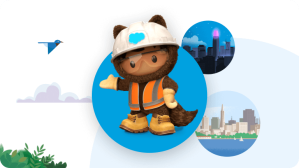Opportunities abound, but are organisations across the built environment sector ready to deliver on the potential of new tech to improve efficiency and innovation, better engage with customers, and drive measurable sustainability initiatives?
Escalating inflation. Rising interest rates. Supply chain disruptions. The quickening pace of the march to net zero… A significant confluence of factors by any stretch of the imagination. But arguably, I’d venture, they pose a particular challenge to organisations in the built environment sector.
Combined with the impact of new working patterns that are changing the landscape of our cities and regional centres, the property management, real estate, and construction companies that make up the built environment have a big task ahead of them.
In this climate, getting closer to customers is integral to gaining a competitive advantage. This means using data and insights to strengthen relationships and create loyalty. And providing seamless digital channels that enable easier interactions and help win business. But to get to this point, we need to start with the basics.
Build from the ground up
Back-office efficiency probably isn’t the sexiest topic on any business exec’s agenda, but it’s a critical building block for innovation. It’s also a major motivator for every built environment organisation today. Given the industry’s sensitivity to inflation and interest rates, addressing any area that can reduce expenditure and maximise the value of the workforce is a clear winner.
Whether it’s freeing talent from mundane manual tasks to focus on stuff that really matters or ensuring HR can seamlessly onboard new starters – staff need tech that makes it easy to be productive. Why have five apps that achieve the same end goal when one will do? This is common in many companies: adding complexity when consolidation of tech will achieve much better outcomes. With the right tools in place, you break down silos, bring teams together, and give everyone in your organisation access to real-time data to make decisions fast.
Taking customer experience seriously
The effectiveness of the tools staff have at their disposal can have a profound effect on client experience. Salesforce customer and facilities management firm Just Ask found this when it worked with us to digitise its field services operations. Not only did it transform employee efficiency through automated scheduling – saving 230 hours and empowering staff with 22% more time – but it also increased satisfaction among staff, helping to improve retainment, which is a big issue in the industry. Perhaps more important than both of these things, Just Ask is now delivering a better, faster service to residents in social housing, supporting the company’s ‘Better Places, Better Lives’ mission.
The point here is that delivering stellar service matters. And let’s face it, customer experience isn’t something the built environment industry is well known for. The sector might be predominantly business-to-business, but we’re all customers, and we all expect services to match up to what we’ve become used to in our consumer-centric world.
Embracing digital and data is key to creating enduring, resilient relationships with customers and clients. It’s about having the tools to connect with customers digitally and know who they are from every angle. It’s not easy though when there are so many different channels of communication, when departments and individuals act in isolation, when there are more apps than employees, and when customer data resides… well, anywhere there’s space for it.
Scale. Innovate. Grow.
There are countless potentially transformative applications of new tech. Internet-of-Things-enabled devices that improve safety and visibility on construction projects. Big data that helps real-estate businesses predict market demand. Artificial intelligence (AI) to speed up complex contract generation. Drones that make maintenance faster and more cost-effective. But when you’re still running countless processes on a spreadsheet, pursuing this type of innovation is much like running before you can walk.
Leading global commercial real estate company Cushman & Wakefield provides a great example of technology-led innovation in action. With ambitious emissions reduction targets, it wanted to turbo-charge its progress to net zero. Sustainability is a key priority everywhere, but especially in the built environment sector, which directly accounts for 25% of UK emissions. (the same report found that 19% of the UK’s carbon footprint comes from the energy needed to heat, cool, and power our buildings). So, we worked with Cushman & Wakefield to ensure it had the insight to deliver on its targets, using what-if analysis aligned to science-based targets and forecasting. This is helping the company – and its clients – monitor and reduce emissions and get to net zero faster.
It’s a real success story of the power of AI, data, and customer relationship management combined – and applied at scale – within the commercial real estate industry to achieve significant progress in a critical area.
From gloom to boom
Despite the picture of macroeconomic gloom I painted at the beginning, the longer-term outlook for the sector is far from bleak, with significant opportunity for agile players who have the tools to achieve greater stability by making the right decisions for their businesses and clients. For one, while housebuilding has taken a hit due to rising mortgage rates, the undersupply of housing is acute and the requirement to deliver more homes is more urgent than ever. Construction, when it ramps up, will likely be at a faster pace than before. In addition, demand in the commercial sector remains strong as companies look at how traditional office space can be repurposed to provide housing or made into hybrid environments that better reflect the needs of people and businesses today.
In short, there are huge opportunities to deliver new experiences that positively impact people and society. The organisations that succeed will be the ones that have built a solid foundation – based on technology that unites data, people, and systems – to connect with customers and deliver solutions that meet demand.
Salesforce for Built Environment
Create a single source of truth within real estate, facilities management, and the construction industry.




























